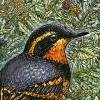

Join BirdNote tomorrow, November 30th!
Illustrator David Sibley and actor H. Jon Benjamin will face off in the bird illustration battle of the century during BirdNote's Year-end Celebration and Auction!
Birds’ four-chambered hearts run larger than those of mammals, relative to body size, and they are coupled with extremely efficient cardiovascular systems. The energy demands of flight require these adaptations. An exercising human has a heart rate around 150 beats per minute. In contrast, an active hummingbird’s heart pumps at 1,200 beats per minute; a flying pigeon’s heart beats at 600.
BirdNote®
The Heart of a Bird
Written by Bob Sundstrom
This is BirdNote.
[Pileated Woodpecker]
[Carolina Chickadee]
Birds, like mammals, are warm-blooded. It’s an adaptation known as endothermy. Along with feathers and other key anatomical features, endothermy is a fundamental trait carried over from their non-avian dinosaur ancestors, active hunters known as theropods – like the fearsome Velociraptor or the T-Rex.
Birds’ bodies maintain a constant temperature, around 106 degrees. Their four-chambered hearts run larger than those of mammals, relative to body size, and they are coupled with extremely efficient cardiovascular systems.
Birds are built for a high-energy lifestyle. Their hearts pump more oxygen-rich blood per minute than those of mammals. The energy demands of flight require it. And smaller animals lose body heat more rapidly, burning the oxygen in their blood faster than larger animals.
An active hummingbird’s heart pumps at twelve hundred beats per minute; a flying pigeon’s heart beats at 600.
[Broad-tailed Hummingbird]
But a human athlete during exercise builds up a heart rate to around only 150 beats, a mere fraction of the hummingbird’s heart rate.
Exercise as hard as you like. Your heart will stay in the slow lane compared to that of a bird.
[Broad-tailed Hummingbird]
For BirdNote, I’m Michael Stein.
Support for BirdNote is provided by Jim and Birte Falconer from Seattle, Washington, and generous listeners around the world.
###
Senior Producer: John Kessler
Production Manager: Allison Wilson
Producer: Mark Bramhill
Associate Producer: Ellen Blackstone
Digital Producer: Conor Gearin
Bird sounds provided by The Macaulay Library of Natural Sounds at the Cornell Lab of Ornithology, Ithaca, New York. Pileated Woodpecker ML163779981 recorded by N. Pieplow, Carolina Chickadee ML163782411 recorded by N. Pieplow, Broad-tailed Hummingbird ML 6177 recorded by R. Stein, and Broad-tailed Hummingbird ML 109040 recorded by G. Keller.
BirdNote’s theme was composed and played by Nancy Rumbel and John Kessler.
© 2021 BirdNote November 2021 January 2024
Narrator: Michael Stein
ID# heart-01-2021-11-03 heart-01
References
http://www.tiem.utk.edu/~gross/bioed/webmodules/cardiacoutput.html
https://www.abc.net.au/science/articles/2010/11/23/3073903.htm





